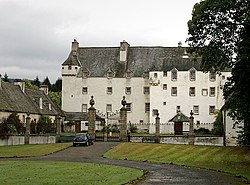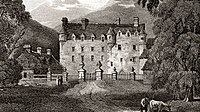Traquair House: Difference between revisions
Created page with "{{Infobox house |name=Traquair House |county=Peeblesshire |picture=Traquair House - geograph.org.uk - 4674.jpg |picture caption=Traquair House |latitude=55.608372 |longitude=-..." |
|||
| Line 34: | Line 34: | ||
*"The Dining Room", one of the last additions to the house, built in the late 17th century. | *"The Dining Room", one of the last additions to the house, built in the late 17th century. | ||
There is a Roman Catholic | There is a Roman Catholic chapel built in 1829, following the Roman Catholic Relief Act. The 18th century library contains more than 3,000 volumes. Although three lairds made alterations to the house, prior to the 17th century, Traquair has changed little, architecturally, since then. | ||
The Bear Gates at the main entrance to the grounds were installed by the fifth Earl, Charles Stuart, in 1738. When they were closed, after Charles Edward Stuart (Bonnie Prince Charlie) passed through in 1745, the Earl vowed they would never be opened again until a Stuart king returned.<ref>{{cite web|url=http://www.traquair.co.uk/brief-history-traquair-and-family|title=A Brief History of Traquair and the Family|work=traquair.co.uk}}</ref> | The Bear Gates at the main entrance to the grounds were installed by the fifth Earl, Charles Stuart, in 1738. When they were closed, after Charles Edward Stuart (Bonnie Prince Charlie) passed through in 1745, the Earl vowed they would never be opened again until a Stuart king returned.<ref>{{cite web|url=http://www.traquair.co.uk/brief-history-traquair-and-family|title=A Brief History of Traquair and the Family|work=traquair.co.uk}}</ref> | ||
Latest revision as of 19:30, 31 May 2015
| Traquair House | |
| Peeblesshire | |
|---|---|
 Traquair House | |
| Location | |
| Location: | 55°36’30"N, 3°3’50"W |
| History | |
| Country house | |
| Information | |
| Owned by: | Maxwell Stuart family |
| Website: | traquair.co.uk |
Traquair House in Peeblesshire, approximately 5 miles southeast of Peebles, is claimed to be the oldest continually inhabited house in Scotland. While not strictly a castle, it is built in the style of a fortified mansion. It predates the Scottish Baronial style of architecture, and may have been one of the influences on this style. It contains a brewery which makes Jacobite Ale and House Ale.
History

The house is built on the site of a hunting seat used by the Scottish kings from the 12th century, though no part of the present building can be dated with certainty before the 15th century. Alexander I was the first king to stay and hunt at Traquair. At that time it was a remote "castle", surrounded by forest. On the death of Alexander III in 1286 and the ensuing succession crisis, the peace of the border shire was shattered and Traquair became a key link in the chain of defence that guarded the Tweed Valley against attacks from England or from Scotland, depending on which side held the castle at the time.
Over the next two centuries, Traquairs ownership changed often, at times coming under the control of the English crown and at others the various claimants to the Scottish crown.
In the 1460s, King James III conferred the estate on Dr William Rogers, an eminent musician, and one of his favourites. After holding the lands for upwards of nine years, Dr. Rogers sold them for an insignificant sum, in 1478, to the Earl of Buchan. The Earl granted the estate to his illegitimate son, James Stuart (1480-1513), 1st Laird of Traquair, in 1491. James Stuart obtained letters of legitimation, and married the heiress of the Rutherfords, with whom he received the estates of Rutherford and Wells in Roxburghshire. James was killed at the Battle of Flodden. His daughter, Lady Jane Stuart, became involved with the married Earl of Angus, by whom she had a daughter out of wedlock, Lady Janet Douglas (d.1552). Janet married Patrick Ruthven, 3rd Lord Ruthven and produced several children and the main Ruthven line.
Traquair remained the family seat of the Earls of Traquair for the next four centuries.
In 1875 Traquair passed to a cousin of the Stuarts, Henry Constable Maxwell. He was a direct descendant, but by way of the female line. The current laird of Traquair is Catherine Maxwell Stuart.
Features
Traquair is a 50-room house. The rooms include:
- "The Drawing Room", containing ancestral portraits and photographs of the current residents;
- "The Dressing Room", which is decorated to demonstrate life in former times;
- "The Museum Room", containing a mural dating from 1530, one of the oldest to survive in a secular building in Scotland, as well as charters stamped with the royal seals and signatures of the Kings;
- "The King's Room", where Mary, Queen of Scots stayed in 1566 and which contains some relics belonging to her and the Jacobites, such as her rosary, crucifix, purse, a silk quilt, and letters bearing her signature;
- "The Still Room", where breakfast is taken among the 18th century porcelain that decorates the shelves; and
- "The Dining Room", one of the last additions to the house, built in the late 17th century.
There is a Roman Catholic chapel built in 1829, following the Roman Catholic Relief Act. The 18th century library contains more than 3,000 volumes. Although three lairds made alterations to the house, prior to the 17th century, Traquair has changed little, architecturally, since then.
The Bear Gates at the main entrance to the grounds were installed by the fifth Earl, Charles Stuart, in 1738. When they were closed, after Charles Edward Stuart (Bonnie Prince Charlie) passed through in 1745, the Earl vowed they would never be opened again until a Stuart king returned.[1]
The garden contains a recently planted maze. An annual Traquair Fair is held on the first weekend in August.
Brewery
The Traquair House Brewery was started in 1965 by Peter Maxwell Stuart using the 18th century domestic brewery equipment that had previously been used to make beer for the house.[2] The brewery makes a range of beers, though the two main brands are Jacobite Ale and House Ale.[3]
Ale was brewed at Traquair during the reign of Mary, Queen of Scots. In 1739 a 200-gallon copper was installed in the brew house under the chapel.
Outside links
| ("Wikimedia Commons" has material about Traquair House) |
References
- ↑ "A Brief History of Traquair and the Family". traquair.co.uk. http://www.traquair.co.uk/brief-history-traquair-and-family.
- ↑ Traquair House Brewery - Traquair House
- ↑ "Traquair, Innerleithen, Borders, Scotland - RateBeer". ratebeer.com. 2012. http://www.ratebeer.com/brewers/traquair/342/. Retrieved 30 September 2012.
